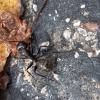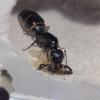My colonies have been in the fridge since late September, although I have checked on them from time to time just to see that they had water, and maybe offering food. (they ignored it)
But this month checking on them I found that they all took food RAVENOUSLY. My Camponotus discolor have eaten 6 crickets in 6 days. I gave them two today and they are gone. The rest are eating again too:
Camponotus Pennslyvanicus: Some eggs and larva present NO pupae. Over the winter they had zero eggs and pupae but I think the queen has started again. They have eaten two crickets per colony over the past week. I'm still keep them cold, but not as cold as before. They are at 58F for now.
Camponotus Discolor: I took them out and they are in a 65F room very active, but I see no eggs or brood. They are eating as much as I can manage to give them. I think I'll give them some cat food too.
Nylanderia sp. - They have a massive brood pile that they made in the cold fridge! They are out now in the the room and have nibbled some foods. They have pupae, eggs and larva and have had these all winter.
Lasius Neoniger - They have a massive brood pile like Nylanderia and had larva all winter, but now they have eggs too. No pupae at all yet.
Formica Subserica - Big pile of eggs and a few tiny larva. They had no brood starting in early AUGUST and frankly I was worried they were going to go sterile. But I think they just like to lay early and stop early?
Pogonomyrmex Occidentalis -They have zero brood or eggs but have resumed making bread from their seed stores. I'm warming them up and may need to give them a heat mat since they seem to be desperate for any warmth.
Orphans of a Lasius sp. - They of course have no brood but are still doing OK and ate a fly together even though there are only 9 of them.
















